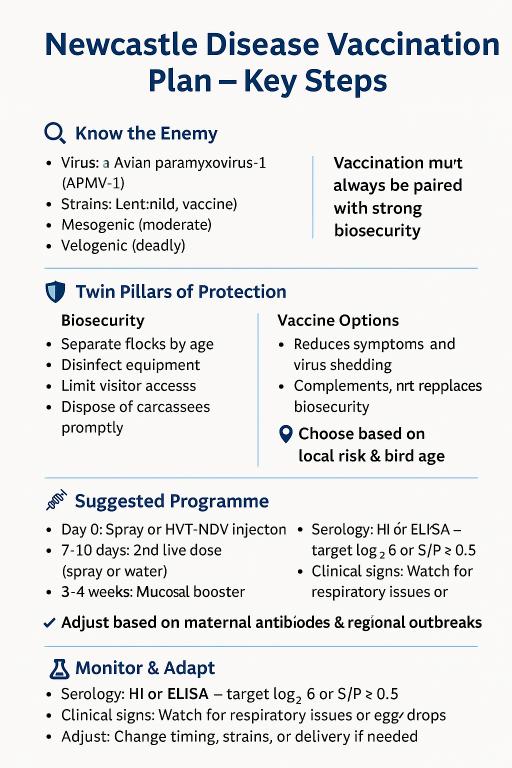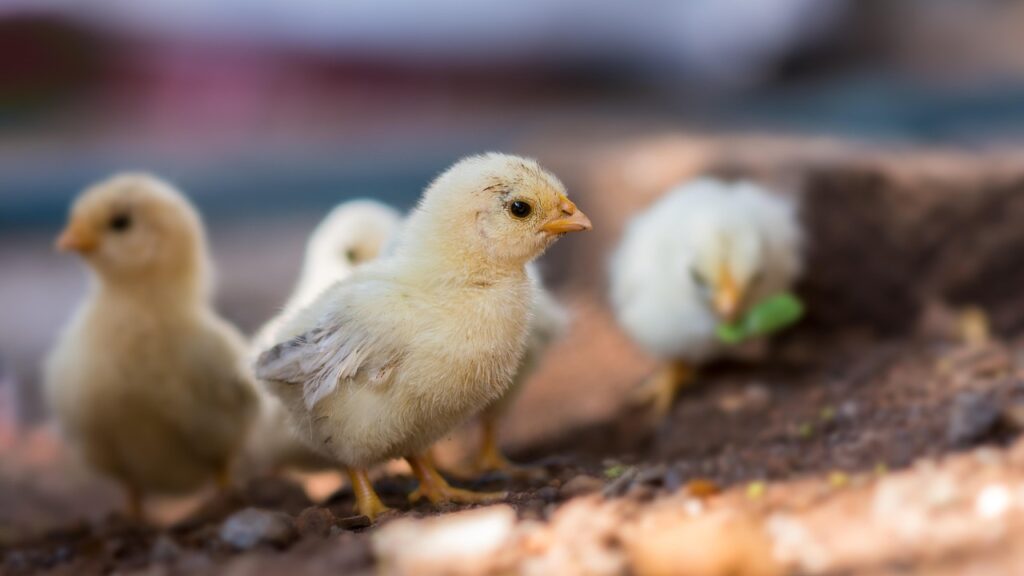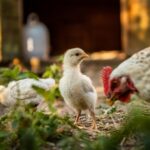Newcastle Disease (ND) remains one of the most costly threats to both commercial and backyard poultry worldwide due to its high rates of mortality and morbidity. A well-designed vaccination plan, supported by rigorous biosecurity, can turn this highly contagious virus from an existential danger into a manageable risk.
Key Takeaways:
- Newcastle Disease is highly contagious and deadly; prevention hinges on vaccination plus strict biosecurity.
- Four vaccine types are used strategically: live lentogenic, live mesogenic, inactivated, and recombinant vector (HVT-NDV).
- Timing matters: start at day-old, then boost at 7–10 days, 3–4 weeks, and pre-lay depending on local risk.
- Effective delivery (spray, water, eye-drops, injection) and serological monitoring ensure strong flock immunity.
- Adapt vaccination schedules based on maternal antibody levels, field pressure, and ongoing lab results.
- A vaccination plan is dynamic—refined with data, supported by diagnostics, and improved through industry collaboration.
Know the Enemy
- Causative agent. ND is driven by avian paramyxovirus-1 (APMV-1), genus Avulavirus, family Paramyxoviridae
- Pathotypes in chickens:
- Lentogenic (mild; common vaccine strains)
- Mesogenic (intermediate severity)
- Velogenic (highly virulent—viscerotropic and neurotropic forms)
- Staying power: Survives months in frozen carcasses or eggs; rapidly inactivated by 30 min at 60 °C, direct sunlight, or standard disinfectants.
- Incubation window: Typically 2–15 days, shorter with more virulent strains.
Because birds can shed virus before obvious signs appear—and because the virus persists on equipment and in litter, vaccination must always be paired with tight hygiene.
The Twin Pillars: Biosecurity + Vaccination
Vaccines alone do not stop every virus particle; they mainly prevent severe illness and reduce shedding. Therefore:
- Biosecurity first: Separate flocks by age, limit visitor traffic, disinfect equipment, and dispose of carcasses promptly.
- Vaccination as the safety net: Layered immunity keeps small breaches from becoming farm-wide disasters.
Choosing the Right Vaccine
Four categories form today’s toolbox:
- Live lentogenic (e.g., Hitchner B1, La Sota) – Strong mucosal immunity and cheap mass delivery; protection is shorter and sensitive to disinfectants.
- Live mesogenic (e.g., Roakin, Komarov) – Longer-lasting antibodies; use only after birds have been primed, to avoid reactions in naïve flocks.
- Inactivated oil-emulsion – Very safe and durable, but labor-intensive because every bird needs an injection.
- Recombinant vector (HVT-NDV) – Delivers ND antigens via Marek’s virus; minimal post-vaccinal stress and ideal for day-old hatchery use.
Match vaccine types to local risk: lentogenic for baseline coverage, add mesogenic or inactivated when pressure is high, and consider a recombinant start in hatcheries that already give Marek’s shots.
Timing Your Programme
A practical sequence for most production systems:
- Day-old: Coarse spray of live lentogenic or subcutaneous HVT-NDV vector—immunity starts before chicks meet field virus.
- 7–10 days: Second live spray or drinking-water dose after maternal antibodies wane.
- 3–4 weeks: Another live booster to cement mucosal IgA.
- Grow-out or pre-lay (layers/breeders): Inactivated oil vaccine for long-term systemic antibodies; in high-challenge regions, add a mesogenic “harden-off” just before peak lay.
Adjust these ages by measuring maternal antibody levels and local outbreak timing; a flexible schedule beats a rigid calendar.

Administration Techniques That Work
- Aerosol/spray: Vaccinate during the coolest part of the day; use coarse droplets (~50 µm) to target the upper respiratory tract.
- Drinking water: Remove disinfectants, stabilise pH to ~6.8–7.2, and colour the water so you can see when birds have consumed the full dose.
- Eye-drops: Ideal for small flocks; every chick receives a known dose.
- Injection: Keep oil vaccines at room temperature for smoother flow and change needles often.
Monitoring and Fine-Tuning
- Serology: Run haemagglutination-inhibition (HI) or ELISA on a flock sample three to four weeks after each key shot; aim for flock-mean antibodies around log₂ 6 HI units or ELISA S/P ≥ 0.5.
- Clinical watch: Any rise in respiratory noise, egg drop, or unexplained mortality warrants immediate PCR testing—vaccinated birds can still conceal a field strain.
- Data feedback: If antibody titres sag too soon or field virus breaks through, move boosters earlier, switch strains, or tighten water-sanitation controls.
Continuous Improvement and Collaboration
Stay plugged into:
- Diagnostic labs for rapid PCR genotyping and pathotyping.
- Producer networks that share early warnings when new NDV strains appear.
- Government or NGO programmes offering subsidised surveillance, training, or vaccine cost-sharing.
An effective ND vaccination plan is not a static checklist but a living protocol. Keep the biosecurity gates shut, fine-tune vaccine choices and timing to your flock’s realities, and verify success with hard data. Do that, and Newcastle Disease becomes just another managed risk instead of a headline-grabbing catastrophe.



